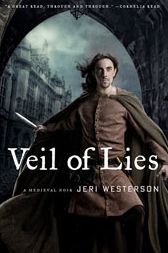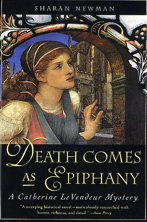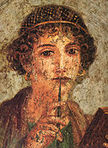Medieval Mysteries: Monks or Knights?
 My favorite on-going medieval series is Jeri Westerson’s Crispin Guest. Crispin is a wonderful and wonderfully original character, “a disgraced knight turned detective on the mean streets of fourteenth century London,” as her website states. Westerson’s gritty world of “medieval noir” is very different from most earlier medieval mysteries, especially the iconic Brother Cadfael books of Ellis Peters, a series which arguably jump-started the genre.
My favorite on-going medieval series is Jeri Westerson’s Crispin Guest. Crispin is a wonderful and wonderfully original character, “a disgraced knight turned detective on the mean streets of fourteenth century London,” as her website states. Westerson’s gritty world of “medieval noir” is very different from most earlier medieval mysteries, especially the iconic Brother Cadfael books of Ellis Peters, a series which arguably jump-started the genre.
Monks or knights? Which shall it be? Of course, Crispin is a knight no longer–at least not technically. He retains, however, a knightly frame of mind even as he is cast down into the lowest dregs of society, living hand-to-mouth. Watching his preconceptions transform as he experiences life as the poor live it, is one of the deepest pleasures of the series. Of course, Crispin no longer moves in courtly circles, though his new work sometimes takes him to his old haunts–a difficult experience, as you can imagine.
One of things that I like about the series is, in fact, that it takes place beyond the confines of courtly circles. While my earliest ventures in historical fiction were typically stories of queens and others who lived among the powerful movers and shakers of the time, nowadays I find that I’m more interested in reading about everyday people and how they lived in distant times.
 Another favorite medieval series, Sharan Newman’s Catherine LeVendeur, fits this mold, too. Whereas Crispin Guest is a bit of a riff on the courtly knight, Newman’s series has a similar tangential relationship to the familiar world of the medieval monastery. Its heroine, Catherine, starts out as a young novice in the convent of the famous Heloise, of star-crossed “Heloise and Abelard” fame, but during the course of the first book Catherine discovers that, despite her scholarly inclinations, her real vocation lies in the world outside the safe confines of the convent. The series seems to have come to a halt, alas, at least for the time being.
Another favorite medieval series, Sharan Newman’s Catherine LeVendeur, fits this mold, too. Whereas Crispin Guest is a bit of a riff on the courtly knight, Newman’s series has a similar tangential relationship to the familiar world of the medieval monastery. Its heroine, Catherine, starts out as a young novice in the convent of the famous Heloise, of star-crossed “Heloise and Abelard” fame, but during the course of the first book Catherine discovers that, despite her scholarly inclinations, her real vocation lies in the world outside the safe confines of the convent. The series seems to have come to a halt, alas, at least for the time being.
Knights, nuns, and monks all possess a certain mystique. They don’t live like other folks. They have lofty concerns–at least in theory. I’m sure I’m not the only child who was fascinated by knights–partly because I also loved horses. I devoured tales of King Arthur, and still today when we’re in a toy store, I can’t pass a display of colorful knights with their emblazoned shields and fancy helmets–and horses–without stopping to pick them up and examine them one by one.
As I grew older, I became fascinated by monasticism, too. It started, I think, with hearing Samuel Barber’s Hermit Songs in a college recital. I loved the music and promptly went out and bought a recording. The back of the album (yes, those were in the days of the LP) listed all the wonderful texts: translations/paraphrases by W.H. Auden of marginalia written by monks in the manuscripts they were copying. I think what appealed to me most about the Hermit Song texts was the prospect of solitude: “Ah, to be all alone, in a little room, with nobody near me …” begins the final song of the cycle, set to a haunting melody that I still can recall word-for-word. A few years later I stumbled on Thomas Merton‘s Seven Storey Mountain and became a Merton groupie. But I’ve never been tempted to actually sign up. I think the prospect of surrendering complete obedience is far more daunting than the other vows of poverty and chastity.But the monastic life continues to fascinate and inspire me.
Though most of us aren’t cut out for the monastic life and none of us lives in the age of knighthood, both lifestyles hold great appeal and account, I believe, for much of the popularity of the medieval mystery genre.
Which do you prefer reading about when you go browsing for medieval fare: knights, nuns, or something else altogether? Stop by and share.











